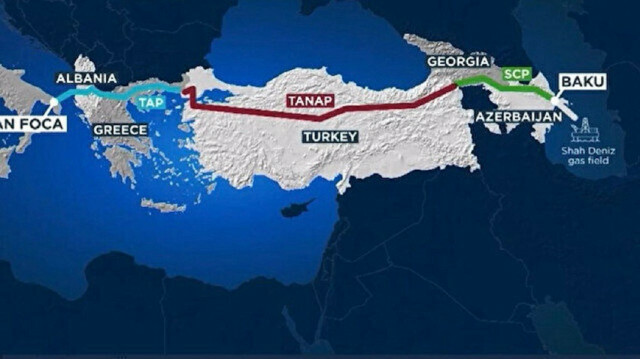

File photo
Located on pipeline transit routes, Türkiye is key for Southern Gas Corridor project, says energy security specialist
The Southern Gas Corridor has come under scrutiny in the EU, with the bloc actively seeking alternative gas resources to ensure long-term supply security in the face of the energy crisis that began with the outbreak of the Russia-Ukraine War.
The halt in Russian supplies to Europe via the Nord Stream 1 and currently defunct Nord Stream 2 natural gas pipelines in response to EU sanctions imposed on Russia exacerbated the EU's energy bottleneck.
Expanding capacity through the Southern Gas Corridor, which transports gas resources from the Caspian Sea to European markets, is one of the most likely options for European nations to speed up liquefied natural gas (LNG) imports to meet their urgent natural gas needs.
The Trans-Anatolian Natural Gas Pipeline (TANAP), known as the "backbone" of the Southern Gas Corridor and the gateway for Azerbaijani gas to Türkiye and Europe, transports 16 billion cubic meters (bcm) of gas annually, 6 bcm of which is offset for Türkiye and 10 bcm for Europe.
TANAP originates at the Georgian-Turkish border, travels 1,811 kilometers through 20 provinces, and connects to the Trans Adriatic Pipeline (TAP) at the Greek border.
Work on pipeline expansion is currently underway to increase its capacity to its maximum, which was originally designed to deliver 32 bcm.
The capacity expansion would be critical for supply security given that Europe now imports 155 bcm of natural gas from Russia each year. However, to increase the volume of gas through the Southern Gas Corridor would require additional reserves and sources.
John Roberts, an energy security specialist from the UK-based research platform Methinks, considers Azerbaijan as a good candidate to help with ramping up supplies via the Corridor.
"The bottom line is, if you're talking about the extra 10 bcm that is the doubling of the corridor, then all we know right now is that by 2027, Azerbaijan might be able to produce about 5 bcm," Roberts told Anadolu Agency.
However, in order for potential markets to tap Azerbaijan's nearly 1.3 trillion cubic meters of proven natural gas reserves, Baku would need to further invest and develop its pipeline network and fields to significantly increase production.
- Two more projected natural gas suppliers: Turkmenistan and Iraq
Roberts explained that the Southern Gas Corridor consists of essentially three sections, "the first two sections have a 16 bcm capacity and the last section has a 10 bcm capacity."
"So, if you talk about doubling the capacity, which is what the EU has been talking about, the impression is that the first section will be expanded to 32 bcm and the second section will be expanded to 20 bcm," he added.
According to Roberts, the first pipeline section does not need to be expanded "that much," but he warned that several factors are at play in relation to the remaining sections.
These factors would need to take into account Türkiye’s demands and interests, as well as its expansion beyond Azerbaijan to Turkmenistan, its close neighbor and a region in which resources can be "plugged into the system very quickly."
"It (Southern Gas Corridor) will be expanded by as much as it is necessary to carry the extra gas through as far as Italy," he said.
He also considered Iraq as a second source option, which could connect to Türkiye without the need to go all the way into Europe.
"There is a prospect, not a certainty, that the northern Iraqi region might be able to start exporting perhaps as much as 5 bcm into southern Türkiye within two or three years," he said.
This would ensure a reduction in Türkiye’s LNG imports, leaving more resources available for Europe to import, he explained.
If that materializes, Roberts argues that there is very little need for this gas to go into the Southern Gas Corridor.
"It displaces gas coming in from other sources. So, it boosts the volumes that get consumed in southern Türkiye, which means you don't need to bring gas in from any other party. So, it contributes to Turkey's gas balance, but you don't need to push it all the way through," he said.
Since the mid-1990s, Türkiye and Iraq have collaborated on natural gas projects, one of which was hampered by political unrest in Iraq and neighboring countries to transport Iraqi natural gas via pipeline to Türkiye, with some volumes offloaded for local consumption before a share was transmitted via another route to European markets.
Iraq, one of the largest oil producers in the OPEC group, has been burning large quantities of natural gas that is not commercially viable.
According to the World Bank's 2022 Global Gas Flaring Tracking Report, flaring has steadily increased in Iraq over the last decade, with volumes rising from 13 bcm in 2012 to almost 18 bcm in 2021, which corresponds approximately to the planned capacity expansion of the Southern Gas Corridor.
- Türkiye is strong contender to help Europe's acquisition of natural gas supplies
Roberts said that Türkiye is "brilliantly placed" in terms of both energy and geography to become a gas hub, owing to its location on pipeline transit routes and strategic importance for the Southern Gas Corridor project.
Roberts concluded that with an annual natural gas consumption of 60 bcm, diversified energy resources, and extensive infrastructure consisting of seven international natural gas pipelines, four LNG terminals, including two Floating Storage and Regasification Units (FSRU), and two underground natural gas storage facilities, Türkiye is in a strong position to offer energy supply security in its region and also to Europe.
#Southern Gas Corridor
#EU
#gas sources
